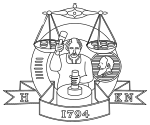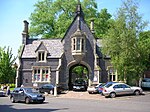Key Hill Cemetery

Key Hill Cemetery, (OS grid reference SP059882), originally called Birmingham General Cemetery, is a cemetery in Hockley (the Jewellery Quarter), Birmingham, England. It opened in 1836 as a nondenominational cemetery (in practice nonconformist), and is the oldest cemetery, not being in a churchyard, in Birmingham. The principal entrance is on Icknield Street to the west, with a secondary entrance on Key Hill to the north. The cemetery contains the graves of many prominent members of Birmingham society in the late 19th century, to the extent that in 1915 E. H. Manning felt able to dub it "the Westminster Abbey of the Midlands".It is the older of two cemeteries in Hockley, the other being Warstone Lane Cemetery, opened in 1847, which was originally reserved for members of the established Church of England. The cemetery is no longer available for new burials.
Excerpt from the Wikipedia article Key Hill Cemetery (License: CC BY-SA 3.0, Authors, Images).Key Hill Cemetery
Cemetery Lane, Birmingham Jewellery Quarter
Geographical coordinates (GPS) Address Website Nearby Places Show on map
Geographical coordinates (GPS)
| Latitude | Longitude |
|---|---|
| N 52.491 ° | E -1.915 ° |
Address
Hursts
Cemetery Lane
B18 5PB Birmingham, Jewellery Quarter
England, United Kingdom
Open on Google Maps









